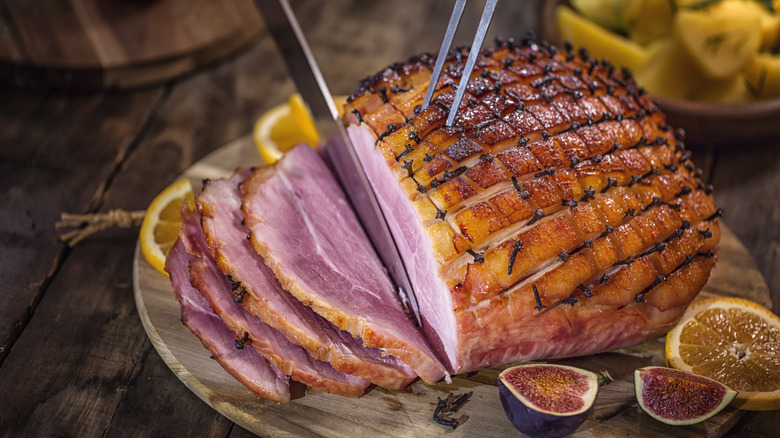Is Ham Technically Red Or White Meat?
Americans love ham — they eat it in sandwiches, in soups, and let's not forget the beloved Christmas ham that often graces tables around the holidays. But what exactly is ham when it comes to the categories of white and red meat? It has a unique color, texture, and flavor compared to most of the other meats we eat. It doesn't resemble the redness of steaks, nor does it take on the paler color of a cooked pork tenderloin. Is it red meat, white meat, or neither?
Ham comes from a hog's hind leg, which means it is pork and therefore red meat, regardless of its actual color. On that note, why does it have that signature pinkish color instead of the bright red of raw red meat, or the pinkish-grey of cooked red meat? The color actually comes from the curing process that raw pork undergoes in order to become a ham. There are multiple ways to cure a ham, but for most common American supermarket hams made for baking or roasting, the meat is injected with sodium nitrate. This breaks down proteins in the meat, including the red-colored protein myoglobin, and turns the meat pink.
What is red meat?
The easiest way to define red meat is that it comes from mammals, from cows and pigs to game meat like deer. White meat, on the other hand, generally refers to poultry. This is why beef, lamb, and pork (including ham) are considered red meat. Red meat is high in protein, as well as vitamins like B12, iron, and zinc (per Healthline).
The main difference between red meat and white meat on a purely aesthetic level lies in the amount of myoglobin. This red-pigmented protein controls oxygen delivery to the muscles, and the more of it an animal has in its muscles, the redder the meat appears when raw. However, when most red meat is cured, it turns pink. This is why ham, as well as several other cured meats like bacon, are pink. Whether you're eating prosciutto, jamón ibérico, mortadella, soppressata, or coppa, you're eating cured red meat made from different parts of the pig.


